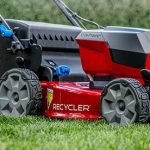One question that divides lawn mowing enthusiasts is how fast you should ride your mower. In truth, there is no individually correct answer for the appropriate pace at which you should operate your mower. You should make your decision based not only on equipment, but also considering your familiarity with the terrain and the specifications of your materials. In this post, we review the advantages and disadvantages of mowing faster or slower.
For years, lawn mower experts have preached the values of mowing slower, and from a “what’s best for your lawn” standpoint, it really is optimal to mow at a more relaxed pace. This is because if you mow too fast, you’re going to tear through the grass instead of giving it the even cut that is best for your lawn. When the grass gets torn, it winds up brown, which isn’t going to get you rave reviews if you run a mowing business!
Mowing wet grass is never ideal, but when doing so it is even more essential that you mow slowly—you should cut your speed roughly in half. Wet grass is far more likely to clog up you mower, and so by reducing the speed you help ensure that the clippings successfully go through the mower.
When using a mower with variable speeds, you want to veer towards the lower end of the spectrum. If you have a dual range mower, you should restrict yourself to riding no higher than L3, or possibly H1 if the terrain is flat and you have a good deal of experience with the mower and the land. However, when dealing with a PTO shaft, you should make sure that you steer clear of the 540 PTO speed. Cutting too fast will cause damage to your deck belt, so in order to protect your equipment, make sure that you don’t go overboard with your speed.
Lawn mower speed is complicated by time and money factors. It’s natural that you want to mow as quickly as possible, either for your business or your personal lawn. If you mow around 4 miles per hour, that should be a happy compromise between what’s best for both you and your lawn. Ultimately, be sure to take a moment to evaluate the terrain before beginning a mowing job, and don’t be afraid to adjust accordingly after you start.







